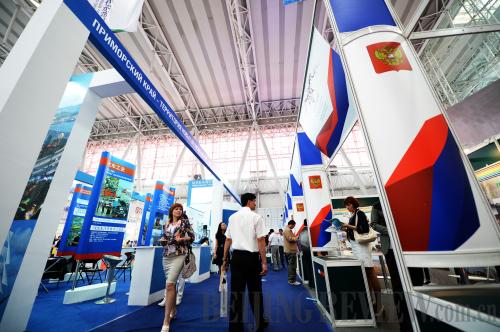|
 |
|
RUSSIAN PRESENCE: Visitors check out the Russian Exhibition Area at the Harbin trade fair (WANG KAI) |
"Aipu is geared to serving residents in cold regions by manufacturing products adapted to low temperatures. The Harbin trade fair is a platform for us to tell investors what we can offer," said an Aipu manager.
Considering cultural differences, Aipu hopes to partner with Russian businesses and take advantage of their local sales network. "They know better about their fellow countrymen and what kind of products local people need, which will help facilitate our exports," said Liu.
Unlike years past, this year's trade fair laid a focus on art products in hopes of facilitating and furthering business ties.
In the 3,000-square-meter exhibition hall, hundreds of oil paintings by prestigious Russian artists were displayed in exquisite wooden frames, all for sale, and there was even a forum on Russian oil paintings.
"Along with my oil paintings, I also traveled with many friends and colleagues to Harbin. I'd like to introduce them to Chinese art lovers and make close contacts with them," said Sergei Gore, an academic from the Russian Academy of Sciences.
For Valery Alexandrovich, dean of the art school at Herzen University in St. Petersburg, art is a starting point for the two countries to build commercial ties. "The art show allows Russia and China to learn more about each other."
Trade ties
In the past two decades, trade between China and Russia has increased 14 fold, while China has ranked as Russia's largest trading partner for two consecutive years.
At the fair's Russian Business Day event on June 15, Wang noted that the booming China-Russian trade relationship would help realize an annual trade value of $100 billion.
Since it was established at the 2005 Harbin trade fair, the Russian Business Day has morphed into a platform to deepen ties between the two countries. As a major part of the fair, Russian Business Day has been upgraded from a provincial-level workgroup meeting to a ministerial bilateral forum on bilateral economic and trade cooperation.
The forum was themed "Opportunities for Russia-China Cooperation, Innovation and Development," indicating a strong aspiration to expand all-round ties. People who were present at the fair exchanged views on Russian Far-East development planning and policies designed to spur investment.
"Enterprises from China and Russia should have a deep understanding of each other's investment environment and development potential and complement each other in terms of geography, capital and technology," said Wang at the forum on June 15.
"China is one of Russia's important partners. Fruitful results have been yielded through interaction between the two," said S.B. Ivanova, Russia's State Secretary and Vice Minister of Regional Development.
Statistics show that China-Russia trade stood at $88.2 billion in 2012, up 11.2 percent from a year ago. Wang said booming trade between both sides were as a result of a number of strategic projects on energy, aviation and nuclear energy.
Valery V. Kuleshov, Director of the Institute of Economics at the Russian Academy of Sciences, said at the fair that the Russian Government is making enormous strides in building an energy base in the North Pole, and China should try to be a part of it.
Now, Russia's oil and gas exploration wells have been built within 100 km from the Arctic Circle. Due to difficult weather conditions at the North Pole, the exploitation will be arduous and expensive. According to preliminary estimates, the exploitation of north Russia's continental shelf would cost trillions of dollars.
"But it'll all be worth it because cooperation on exploiting the North Pole would enhance China-Russia relations and benefit both sides," said Kuleshov.
(Lu Bo also contributed to the story)
Email us at: dengyaqing@bjreview.com | 